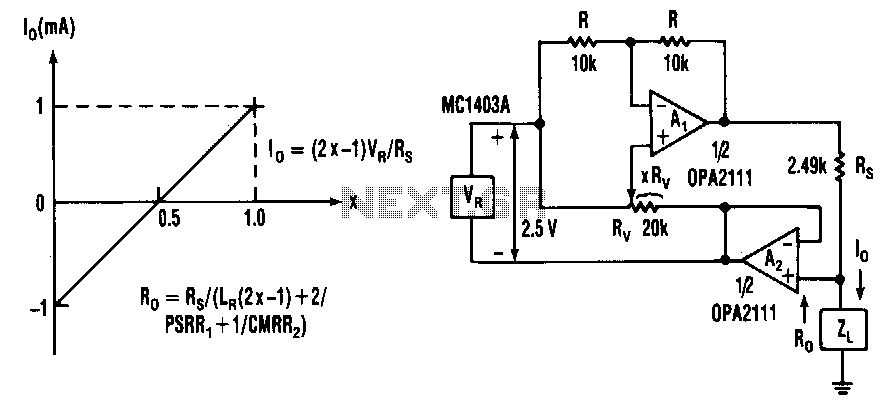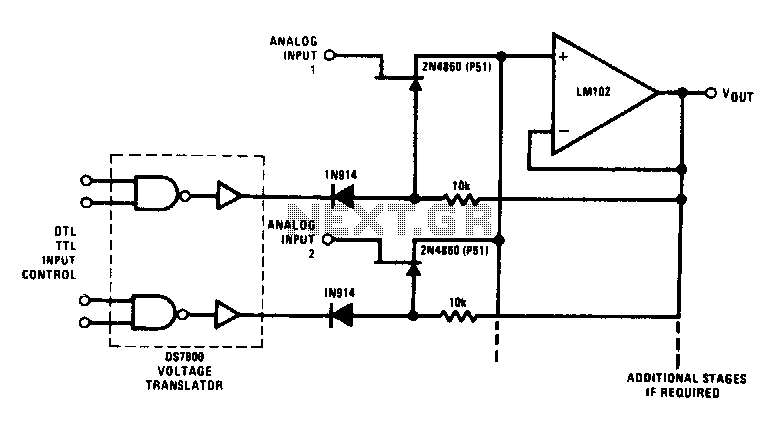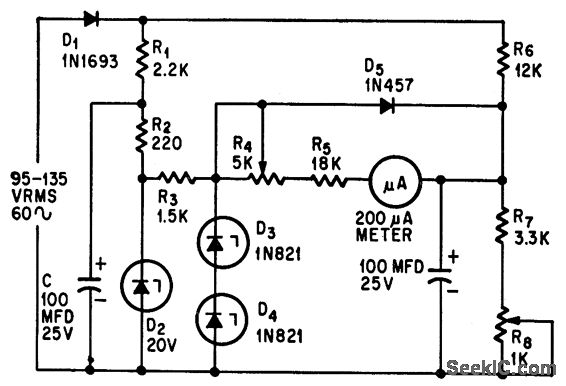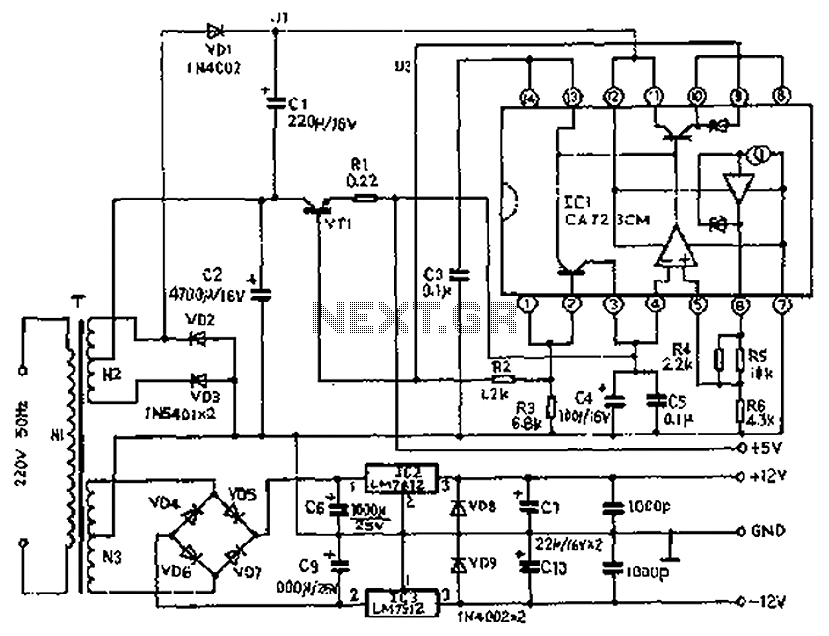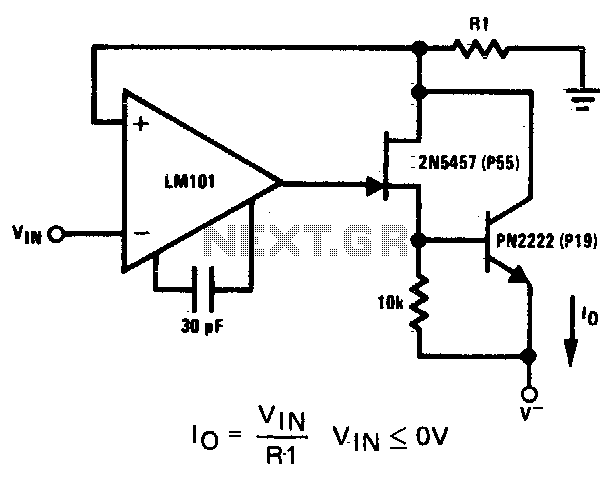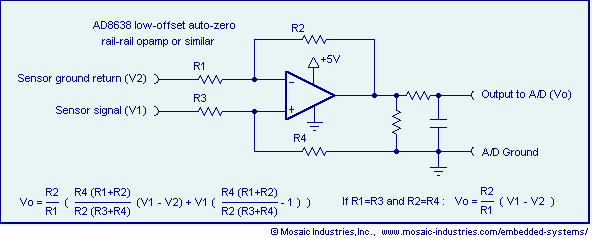
Precision buffered reference
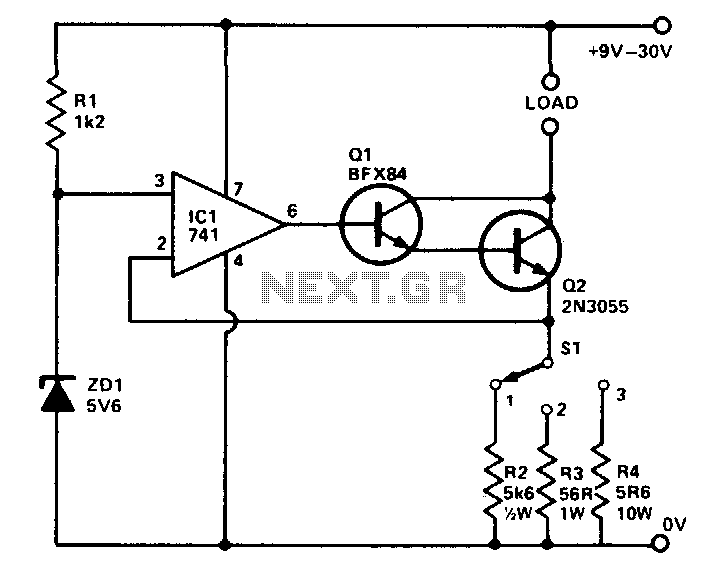
The circuit provides three preset currents that remain constant despite variations in ambient temperature or line voltage. A temperature-stable reference voltage is produced by ZD1 and applied to the non-inverting input of IC1. A 100% feedback is applied from the output to the inverting input, ensuring that the voltage at the emitter of Q2 is maintained at the same potential as the non-inverting input. The current flowing into the load is therefore determined solely by the resistor selected by S1. With the values used in this design, preset currents of 10 mA, 100 mA, or 1 A can be selected. Q2 should be mounted on an appropriate heatsink.
The circuit described operates as a constant current source, which is crucial for applications requiring stable current levels regardless of fluctuations in temperature or supply voltage. The primary component, ZD1, functions as a Zener diode that provides a stable reference voltage, which is essential for maintaining the integrity of the circuit's operation. This reference voltage is fed into the non-inverting input of operational amplifier IC1, which compares it with the feedback voltage from the output.
The feedback mechanism employed in this circuit is vital for its functionality. By applying 100% feedback from the output to the inverting input of IC1, the circuit effectively creates a control loop that adjusts the output voltage to match the reference voltage. This ensures that the voltage at the emitter of transistor Q2 remains consistent with the reference voltage, thereby stabilizing the output current.
The selection of current levels is facilitated by the resistor connected to switch S1. By changing the resistor value, the user can select between the preset currents of 10 mA, 100 mA, or 1 A. This versatility makes the circuit adaptable for various applications, from powering small sensors to driving larger loads.
Thermal management is also a critical consideration in this design. Transistor Q2, which handles the load current, should be mounted on an appropriate heatsink to dissipate excess heat generated during operation. This thermal management ensures that the transistor operates within safe limits, preventing thermal runaway and maintaining the reliability of the circuit over prolonged use.
Overall, this circuit design exemplifies a robust solution for applications requiring stable and adjustable current sources, with built-in safeguards against environmental fluctuations and thermal issues.The circuit will provide 3 preset currents which will remain constant despite variations of ambient temperature or line voltage. ZDl produces-a temperature stable reference voltage which is applied to the noninverting input of ICl.
100% feedback is applied from the output to the inverting input holding the voltage at Q2s emitter at the same potential as the noninverting input. The current flowing into the load therefore is defined solely by the resistor selected by Si With the values employed here, a preset current of 10 mA, 100 mA or 1 A can be selected. Q2 should be mounted on a suitable heats ink. 🔗 External reference
The circuit described operates as a constant current source, which is crucial for applications requiring stable current levels regardless of fluctuations in temperature or supply voltage. The primary component, ZD1, functions as a Zener diode that provides a stable reference voltage, which is essential for maintaining the integrity of the circuit's operation. This reference voltage is fed into the non-inverting input of operational amplifier IC1, which compares it with the feedback voltage from the output.
The feedback mechanism employed in this circuit is vital for its functionality. By applying 100% feedback from the output to the inverting input of IC1, the circuit effectively creates a control loop that adjusts the output voltage to match the reference voltage. This ensures that the voltage at the emitter of transistor Q2 remains consistent with the reference voltage, thereby stabilizing the output current.
The selection of current levels is facilitated by the resistor connected to switch S1. By changing the resistor value, the user can select between the preset currents of 10 mA, 100 mA, or 1 A. This versatility makes the circuit adaptable for various applications, from powering small sensors to driving larger loads.
Thermal management is also a critical consideration in this design. Transistor Q2, which handles the load current, should be mounted on an appropriate heatsink to dissipate excess heat generated during operation. This thermal management ensures that the transistor operates within safe limits, preventing thermal runaway and maintaining the reliability of the circuit over prolonged use.
Overall, this circuit design exemplifies a robust solution for applications requiring stable and adjustable current sources, with built-in safeguards against environmental fluctuations and thermal issues.The circuit will provide 3 preset currents which will remain constant despite variations of ambient temperature or line voltage. ZDl produces-a temperature stable reference voltage which is applied to the noninverting input of ICl.
100% feedback is applied from the output to the inverting input holding the voltage at Q2s emitter at the same potential as the noninverting input. The current flowing into the load therefore is defined solely by the resistor selected by Si With the values employed here, a preset current of 10 mA, 100 mA or 1 A can be selected. Q2 should be mounted on a suitable heats ink. 🔗 External reference
Warning: include(partials/cookie-banner.php): Failed to open stream: Permission denied in /var/www/html/nextgr/view-circuit.php on line 713
Warning: include(): Failed opening 'partials/cookie-banner.php' for inclusion (include_path='.:/usr/share/php') in /var/www/html/nextgr/view-circuit.php on line 713
